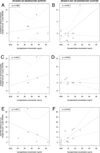Systemic Absorption of Cyclopentolate and Adverse Events After Retinopathy of Prematurity Exams
- PMID: 27159349
- PMCID: PMC5209797
- DOI: 10.3109/02713683.2015.1136419
Systemic Absorption of Cyclopentolate and Adverse Events After Retinopathy of Prematurity Exams
Erratum in
-
Corrigendum.Curr Eye Res. 2018 Aug;43(8):1065. doi: 10.1080/02713683.2018.1489450. Epub 2018 Jul 9. Curr Eye Res. 2018. PMID: 29985656 No abstract available.
Abstract
Purpose: Preterm infants undergoing Retinopathy of Prematurity Eye Exams (ROPEE) may experience adverse events, possibly from systemic absorption of cyclopentolate. The purpose of this study was to analyze the association between adverse events and drug levels found in neonates undergoing ROPEE.
Materials and methods: 25 infants were randomized into two groups during routine ROP screening: 5 infants for blood collection before mydriatic drops and 20 for blood collection 1 h after eye drops. Blood was collected onto dried blood spot cards, extracted, and analyzed for cyclopentolate and phenylephrine using liquid chromatography and mass spectrometry. Relationships between drug levels and adverse events were assessed.
Results: Cyclopentolate (range 6-53 ng/ml) was observed in 15 of 18 infants, while phenylephrine was not detected. Levels of cyclopentolate were significantly higher in infants who were on oxygen (p = 0.01). There was a significant association between cyclopentolate levels and gastric residuals in tube-fed infants not receiving oxygen (p = 0.01).
Conclusions: Cyclopentolate levels varied among preterm infants after ROPEE. Cyclopentolate was positively associated with increased gastric residuals. Underlying medical conditions requiring oxygen administration may affect absorption and metabolism of cyclopentolate. There is a need to predict infants at risk for high blood levels of cyclopentolate in order to prevent or treat adverse events after ROPEE.
Keywords: Adverse events; cyclopentolate; preterm infant; retinopathy of prematurity; screening exams.
Conflict of interest statement
Declaration of interest The authors report no conflicts of interest. The authors alone are responsible for the content and writing of the paper.
Figures



References
-
- Harrell SN, Brandon DH. Retinopathy of prematurity: the disease process, classifications, screening, treatment, and outcomes. Neonatal Netw. 2007;26(6):371–378. - PubMed
-
- Fierson WM. Screening examination of premature infants for retinopathy of prematurity. Pediatrics. 2013;131(1):189–195. - PubMed
-
- Neffendorf JE, Mota PM, Xue K, Hildebrand GD. Efficacy and safety of phenylephrine 2.5% with cyclopentolate 0.5% for retinopathy of prematurity screening in 1246 eye examinations. Eur J Ophthalmol. 2015;25(3):249–253. - PubMed
-
- Ishikawa H, DeSantis L, Patil PN. Selectivity of muscarinic agonists including (+/−)-aceclidine and antimuscarinics on the human intraocular muscles. J Ocul Pharmacol Ther. 1998;14(4):363–373. - PubMed
Publication types
MeSH terms
Substances
Grants and funding
LinkOut - more resources
Full Text Sources
Other Literature Sources
Medical
